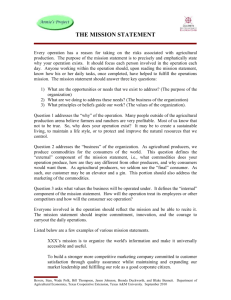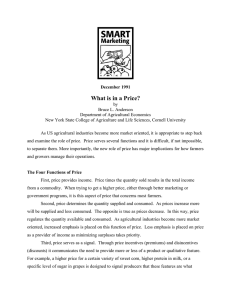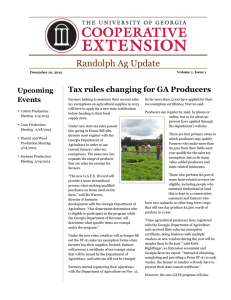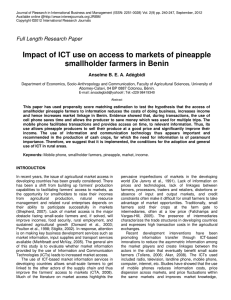Get Ready for More Competitive Markets
advertisement
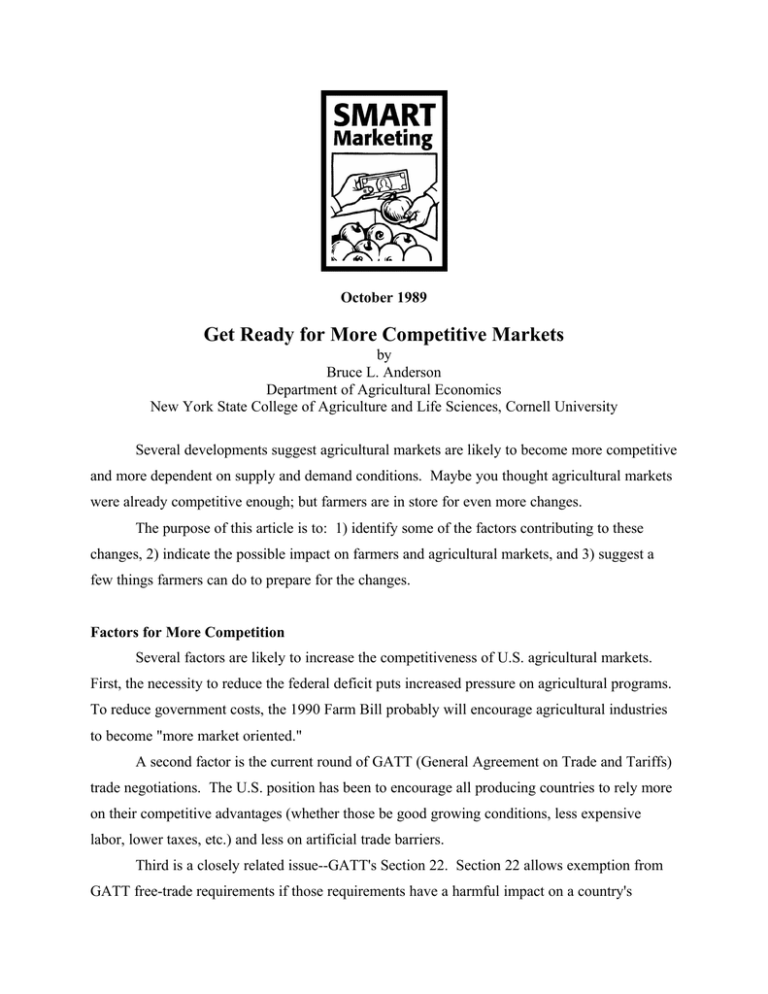
October 1989 Get Ready for More Competitive Markets by Bruce L. Anderson Department of Agricultural Economics New York State College of Agriculture and Life Sciences, Cornell University Several developments suggest agricultural markets are likely to become more competitive and more dependent on supply and demand conditions. Maybe you thought agricultural markets were already competitive enough; but farmers are in store for even more changes. The purpose of this article is to: 1) identify some of the factors contributing to these changes, 2) indicate the possible impact on farmers and agricultural markets, and 3) suggest a few things farmers can do to prepare for the changes. Factors for More Competition Several factors are likely to increase the competitiveness of U.S. agricultural markets. First, the necessity to reduce the federal deficit puts increased pressure on agricultural programs. To reduce government costs, the 1990 Farm Bill probably will encourage agricultural industries to become "more market oriented." A second factor is the current round of GATT (General Agreement on Trade and Tariffs) trade negotiations. The U.S. position has been to encourage all producing countries to rely more on their competitive advantages (whether those be good growing conditions, less expensive labor, lower taxes, etc.) and less on artificial trade barriers. Third is a closely related issue--GATT's Section 22. Section 22 allows exemption from GATT free-trade requirements if those requirements have a harmful impact on a country's agricultural programs. More and more foreign countries are challenging U.S. use of import quotas as a Section 22 exemption, and some of these challenges are likely to be successful. Fourth, the recent Canada - U.S. Free Trade Agreement is probably only the beginning of greater free flow of food and agricultural products between the two countries. Finally, increased concentration among food companies as a result of mergers, acquisitions, and leveraged buyouts will likely increase the difficulty of finding markets and reduce the relative bargaining power of farmers. What All This Means All these developments imply supply and demand forces are likely to play a more important role in coming years. For farmers there is likely to be increased variability in prices with international market conditions having a greater impact than in the past. Commodity prices are likely to equal only the cost of production over time rather than in any given year. Prices will force some producers out of business. In the past, government programs and trade restrictions often protected domestic producers and moderated price swings. Expect less of both in the future. Agricultural producers will also be required to adapt their production practices to be in tune with consumers' wants and needs. Increased emphasis on "fresh" products requires very different production techniques than for processed products. Producers need not be reminded of the changes being forced on them by the increased sensitivity of consumers and citizens to environmental issues. Finally, it will become increasingly important that producers sell their commodities to strong marketing firms. Food manufacturers will also need to become more market oriented. How to Prepare Greater price variability means that, on average, farmers may need to depend somewhat less on borrowed capital and use more equity financing. High levels of debt will be more risky. Farmers should be prepared for several years of low prices while waiting for that "great year" that makes it all worth it. Producers will also need to become more efficient and know their costs of production. Current markets probably provide a greater margin for error than will marketing in coming years. Studies indicate that in several commodities there is a great deal of difference in production costs between farms. More competitive markets are likely to reduce that difference. Knowing your costs will be the key to controlling costs. The changing demands of consumers and processors make producing for the market essential. Currently, high and uniform quality as well as prudent use of chemicals are only two of many important factors. Producers must acquaint themselves with what buyers want, and learn the techniques to produce the desired products. Also in the best interest of farmers is to establish stable relationships with progressive marketing firms. In the future producers will face fewer and fewer market outlets. Buyers will prefer knowing and working with their farmer suppliers to ensure they receive the types of commodities their plants and customers require. Producers will also need to learn how to deal with fewer market alternatives. Finally, producers should realize that with the major structural changes occurring, there will be less opportunity to rely on government programs for assistance. Farmers must be ready and willing to follow market trends and exploit them to their benefit. Summary Agricultural markets are changing. While these changes may pose serious problems and challenges for the production sector, they also provide many opportunities. New York agriculture has a competitive advantage in many areas. Although some adjustments may be painful, good managers will also find vibrant agricultural markets very exciting and economically rewarding.
